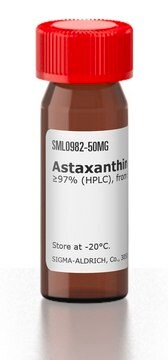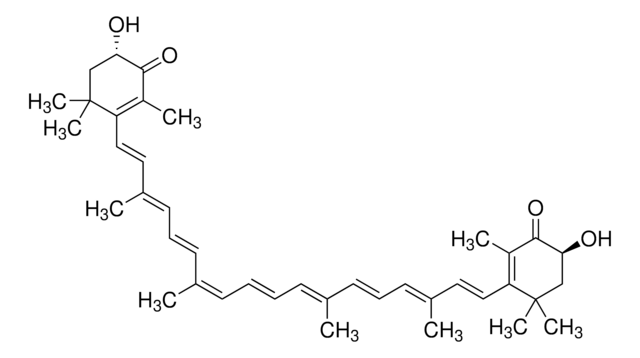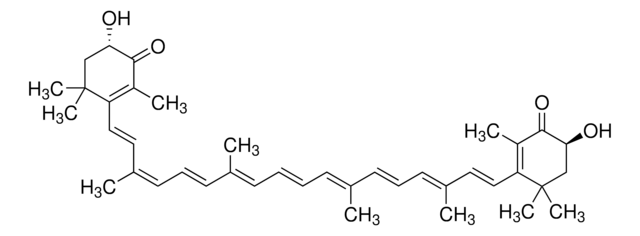41659
Astaxanthin
analytical standard
Sinónimos:
Astaxanthin, (3S,3′S,all-trans)-3,3′-Dihydroxy-β,β-carotene-4,4′-dione, (3S,3′S)-3,3′-Dihydroxy-β,β-carotene-4,4′-dione
About This Item
Productos recomendados
grado
analytical standard
Nivel de calidad
Ensayo
≥97%
caducidad
limited shelf life, expiry date on the label
técnicas
HPLC: suitable
gas chromatography (GC): suitable
aplicaciones
cleaning products
cosmetics
food and beverages
personal care
Formato
neat
temp. de almacenamiento
−20°C
cadena SMILES
CC1=C(/C=C/C(C)=C/C=C/C(C)=C/C=C/C=C(C)/C=C/C=C(C)/C=C/C2=C(C)C([C@@H](O)CC2(C)C)=O)C(C)(C)C[C@H](O)C1=O
InChI
1S/C40H52O4/c1-27(17-13-19-29(3)21-23-33-31(5)37(43)35(41)25-39(33,7)8)15-11-12-16-28(2)18-14-20-30(4)22-24-34-32(6)38(44)36(42)26-40(34,9)10/h11-24,35-36,41-42H,25-26H2,1-10H3/b12-11+,17-13+,18-14+,23-21+,24-22+,27-15+,28-16+,29-19+,30-20+/t35-,36-/m0/s1
Clave InChI
MQZIGYBFDRPAKN-UWFIBFSHSA-N
¿Está buscando productos similares? Visita Guía de comparación de productos
Descripción general
Aplicación
- Microalgae (Green algae), Haematococcus pluvialis using high-performance liquid chromatography (HPLC) with mass spectrometric and fluorescence detection (HPLC-FLD).
- Parapenaeopsis hardwickii using high-performance liquid chromatography (HPLC) with photodiode array detection (PDA).
Acciones bioquímicas o fisiológicas
Envase
Código de clase de almacenamiento
11 - Combustible Solids
Clase de riesgo para el agua (WGK)
WGK 3
Punto de inflamabilidad (°F)
Not applicable
Punto de inflamabilidad (°C)
Not applicable
Equipo de protección personal
Eyeshields, Gloves, type N95 (US)
Elija entre una de las versiones más recientes:
¿Ya tiene este producto?
Encuentre la documentación para los productos que ha comprado recientemente en la Biblioteca de documentos.
Los clientes también vieron
Protocolos
HPLC Analysis of Carotene Compounds on Ascentis® RP-Amide
Contenido relacionado
Separation of Astaxanthin; Xanthophyll
Nuestro equipo de científicos tiene experiencia en todas las áreas de investigación: Ciencias de la vida, Ciencia de los materiales, Síntesis química, Cromatografía, Analítica y muchas otras.
Póngase en contacto con el Servicio técnico












